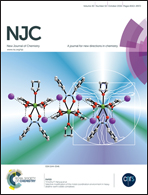Coumarin phenylsemicarbazones: sensitive colorimetric and fluorescent “turn-on” chemosensors for low-level water content in aprotic organic solvents†
Abstract
The water sensing properties of four new efficient two-component colorimetric and fluorescent “turn-on” chemosensors based on the coumarin phenylsemicarbazone skeleton bearing different acceptor/donor functional groups on aniline structural subunits were investigated and are discussed in terms of their photophysical properties, interaction mechanism, sensitivity and substituent effects. Due to the sensing mechanism based on reversible acid–base keto/enolate (hydrazide/hydrazonolate) equilibrium, all the studied coumarin phenylsemicarbazone chemosensors provided rapid and reversible response to low-level water content in polar aprotic solvents. To the best of our knowledge, the determined detection limits for water by studied chemosensors are among the lowest published detection limits in the literature and have competitive sensitivity with chemodosimeters. Their deficiency is, however, the necessity of F− base presence.


 Please wait while we load your content...
Please wait while we load your content...